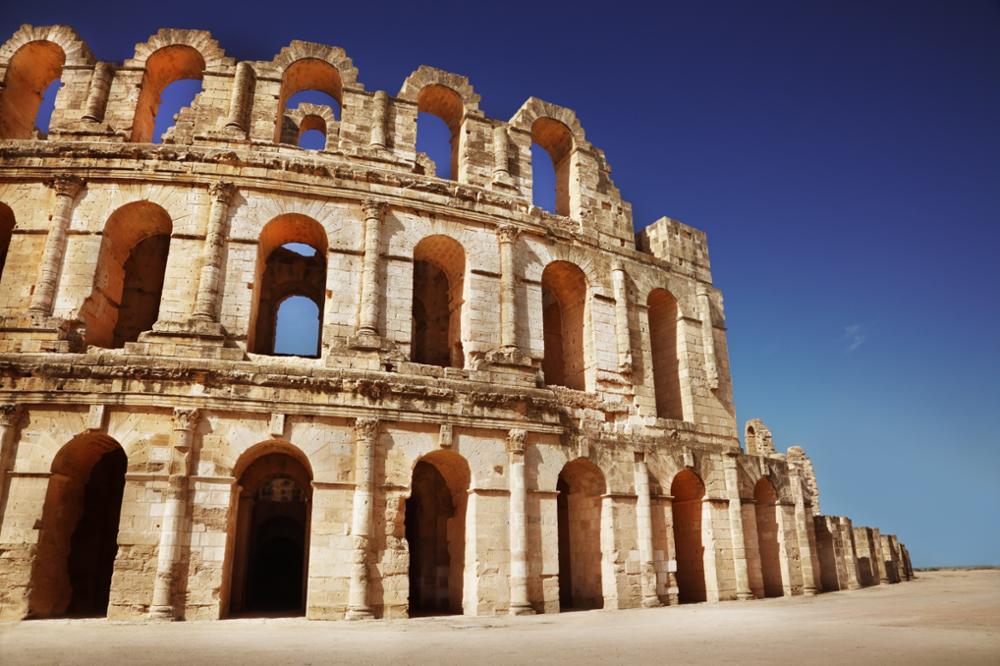
These ruins, some of the best-preserved in the world, tell stories of imperial grandeur, trade, military might, and everyday Roman life.
By the end of the Third Punic War in 146 BC, the Romans had destroyed Carthage and turned its territory into the province of Africa Proconsularis. This fertile and strategically located area became one of the wealthiest provinces of the Roman Empire. It supplied Rome with vast quantities of grain, olive oil, and other goods, and became home to grand cities built in the Roman architectural style.
Often dubbed the “Pompeii of Africa,” Dougga is a UNESCO World Heritage Site and one of the most impressive Roman sites outside Europe. Located in northern Tunisia, it sits atop a hill overlooking a fertile valley.
Highlights:
Capitolium: A majestic temple dedicated to Jupiter, Juno, and Minerva.
Theater: Seating 3,500 people, it still hosts performances today.
Licinian Baths, markets, and a Mausoleum showing Numidian and Roman influences.
The ancient city of Carthage, now a suburb of Tunis, was rebuilt by the Romans in 29 BC after its destruction. It became the capital of Roman Africa.
Highlights:
Antonine Baths: Among the largest Roman baths ever built.
Roman Villas and mosaics.
Tophet, theatre, and amphitheater.
El Djem is home to one of the largest amphitheaters in the world. Built in the early 3rd century AD, it could hold up to 35,000 spectators.
Highlights:
Excellent preservation, especially of the underground passages.
Host to festivals and cultural events.
Echoes of the gladiatorial games that once thrilled crowds.
Located in central Tunisia, Sbeitla boasts remarkably well-preserved ruins of a Roman town.
Highlights:
Capitolium: Three adjacent temples to Jupiter, Juno, and Minerva.
Triumphal Arch of Diocletian.
Baths, forums, and early Christian basilicas showing the transition to Byzantine influence.
Once a Punic town, Thuburbo Majus flourished during the Roman period as a center for veterans and farmers.
Highlights:
Forum and Temple of Mercury.
Summer and Winter Baths.
Rich mosaic floors and a scenic countryside backdrop.
The ruins of Tunisia reveal how Roman urban planning blended with local traditions. Cities were designed with typical Roman features:
Decumanus and cardo (main streets).
Temples, forums, theatres, and bathhouses.
Lavish mosaics, often depicting Roman gods, mythological scenes, and local fauna.
Roman Tunisia was also a center for early Christianity, with many churches and basilicas dating from the 4th and 5th centuries.
Tunisia’s Roman sites are not just archaeological wonders; they are living testimonies to cultural integration, engineering excellence, and the resilience of art and architecture. With relatively few crowds and open landscapes, these sites offer a peaceful and immersive experience into the ancient world.
Best time to visit: Spring (March–May) and Autumn (September–November) for pleasant weather.
Local guides: Hiring a guide enhances understanding of the historical context.
What to bring: Comfortable shoes, water, sun protection, and a good camera.
In conclusion, Tunisia is a treasure trove for history lovers, especially those fascinated by Roman civilization. From grand amphitheaters to sacred temples, the ruins in Tunisia are among the most beautiful and historically rich in the Mediterranean world.